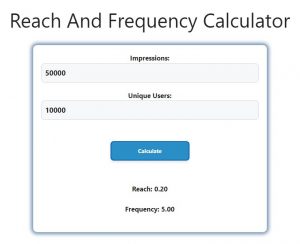About Reach And Frequency Calculator (Formula)
In digital marketing and advertising, understanding the reach and frequency of your campaigns is crucial for optimizing performance and maximizing ROI. Reach refers to the number of unique users who see your ad, while frequency indicates how often these users are exposed to it. The Reach and Frequency Calculator helps marketers determine these essential metrics to better understand their audience engagement and ad saturation.
Formula
The formulas to calculate reach and frequency are:
Reach = Unique Users / Impressions
Frequency = Impressions / Unique Users
How to Use
Using the Reach and Frequency Calculator is simple:
- Enter Unique Users: Input the number of unique users who have seen your ad.
- Enter Impressions: Provide the total number of times your ad has been displayed, including repeated views by the same users.
- Calculate: The calculator will instantly provide both the reach and frequency, offering insights into how well your campaign is performing.
Example
Suppose you have the following data for an ad campaign:
- Unique Users: 10,000
- Impressions: 50,000
Using the formulas:
Reach = 10,000 / 50,000 = 0.2 (or 20%)
Frequency = 50,000 / 10,000 = 5
This means that 20% of the target audience was reached, with each user seeing the ad an average of 5 times.

FAQs
- What is reach in advertising?
Reach refers to the number of unique users who have seen your advertisement at least once. - What is frequency in advertising?
Frequency measures how many times, on average, each unique user sees your ad during a campaign. - Why is reach important?
Reach is important because it indicates how widely your ad is being viewed, helping to ensure that a broad segment of your target audience is exposed to your message. - Why is frequency important?
Frequency helps determine how often your audience is seeing your ad, which can influence their likelihood of taking action, but too much frequency can lead to ad fatigue. - How does increasing frequency affect my campaign?
Increasing frequency can help reinforce your message to your audience, but it can also lead to diminishing returns if the same users see the ad too many times. - What is the optimal frequency for an ad campaign?
The optimal frequency varies by campaign, but many marketers aim for a frequency of 3 to 5 times to ensure the message is memorable without causing fatigue. - Can reach and frequency be too high?
Yes, very high reach with low frequency might mean your audience isn’t seeing the ad enough times, while very high frequency with low reach might indicate ad fatigue and poor budget allocation. - How can I increase reach?
To increase reach, consider broadening your target audience, increasing your ad budget, or diversifying your ad placements. - What if my reach is low but frequency is high?
Low reach with high frequency suggests that your ads are being shown repeatedly to the same small group of users. You may need to expand your audience targeting. - How do reach and frequency relate to impressions?
Impressions are the total number of times an ad is displayed. Reach and frequency break down these impressions into how many unique users are reached and how often they see the ad. - Why does frequency matter in brand awareness campaigns?
Frequency is key in brand awareness campaigns as repeated exposure helps solidify brand recognition in the minds of the audience. - Can reach and frequency metrics help optimize ad spend?
Yes, understanding these metrics can help allocate budget more effectively, ensuring that you’re reaching the right audience without oversaturating them. - What tools can be used to measure reach and frequency?
Many ad platforms, like Google Ads and Facebook Ads, provide built-in tools to measure reach and frequency, but a calculator like this can also offer quick estimates. - How does targeting affect reach and frequency?
Narrow targeting can limit reach but increase frequency, while broad targeting might increase reach but lower frequency. - Is it better to focus on reach or frequency?
The focus depends on the campaign goals. For awareness, reach might be more critical, while for engagement or conversion, frequency might play a bigger role. - What happens if frequency is too low?
If frequency is too low, users may not see your ad often enough to remember or take action on it, reducing the effectiveness of the campaign. - How can I balance reach and frequency?
Balancing reach and frequency often involves adjusting your targeting, budget, and ad placements to ensure a wide yet impactful exposure. - Does higher frequency always lead to better results?
Not necessarily. While moderate frequency can boost recall, excessive frequency can lead to annoyance and negative perceptions of the brand. - What is the relationship between CPM and reach?
CPM (Cost Per Thousand Impressions) impacts reach because a lower CPM allows for more impressions within a given budget, potentially increasing reach. - How do reach and frequency affect return on investment (ROI)?
A well-balanced reach and frequency strategy can enhance ROI by ensuring that your ad dollars are spent effectively in reaching and resonating with your audience.
Conclusion
The Reach and Frequency Calculator is an invaluable tool for marketers looking to optimize their ad campaigns. By understanding these key metrics, you can better manage your ad spend, ensure effective message delivery, and ultimately, improve your campaign outcomes. Use this calculator to strike the right balance between reaching a broad audience and maintaining an impactful presence.
Related: